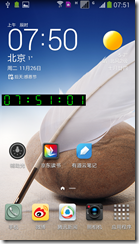桌面控件是通过 Broadcast 的形式来进行控制的,因此每个桌面控件都对应于一个BroadcastReceiver。为了简化桌面控件的开发,Android 系统提供了一个 AppWidgetProvider类 , 它 就 是 BroadcastReceiver 的 子 类 , 也 就 是 说 开 发 者 开 发 桌 面 控 件 只 要 继 承
AppWidgetProvider 类即可。
为了开发桌面控件,开发者只要开发一个继承 AppWidgetProvider 的子类,并重写AppWidgetProvider 不同状态的生命周期方法即可。AppWidgetProvider 里提供如下 4 个不同的生命周期方法。
- onUpdate():负责更新桌面控件的方法;实现桌面控件通常会考虑重写该方法。
- onDeleted():当一个或多个桌面控件被删除时回调该方法。
- onEnabled():当接收到ACTION_APPWIDGET_ENABLED Broadcast 时回调该方法。
- onDisabled():当接收到 ACTION_APPWIDGET_DISABLED Broadcast 时回调该方法。
一般来说,开发桌面控件只需要定义一个 AppWidgetProvider 的子类,并重写它的onUpdate()方法即可,重写该方法按如下步骤进行。
- 创建一个 RemoteViews 对象,创建该对象时可以指定加载指定的界面布局文件。
- 如果需要改变上一步所加载的界面布局文件的的内容,可通过 RemoteViews 对象进行修改。
- 创建一个 ComponentName 对象。
- 调用 AppWidgetManager 更新桌面控件。
如下代码简单的将一张图片作为部件放到桌面上:
public class DesktopApp extends AppWidgetProvider { @Override public void onUpdate(Context context, AppWidgetManager appWidgetManager, int[] appWidgetIds) { // 加载指定界面布局文件,创建RemoteViews对象 RemoteViews remoteViews = new RemoteViews( context.getPackageName(), R.layout.main); //① // 为show ImageView设置图片 remoteViews.setImageViewResource(R.id.show , R.drawable.logo); //② // 将AppWidgetProvider子类实例包装成ComponentName对象 ComponentName componentName = new ComponentName( context, DesktopApp.class); //③ // 调用AppWidgetManager将remoteViews添加到ComponentName中 appWidgetManager.updateAppWidget(componentName , remoteViews); //④ } }
为了实现一个液晶时钟的桌面组件,开发者需要在程序界面上定义 8 个 ImageView,其中 6 个 ImageView 用于显示小时、分钟、秒钟的数字,另外两个 ImageView 用于显示小时、分钟、秒钟之间的冒号。
为了让桌面组件实时地显示当前时间,程序需要每隔 1 秒更新一次程序界面上的 6 个ImageView,让它们显示当前小时、分钟、秒钟的数字即可。
LED电子时钟桌面部件依赖如下代码实现:
main.xml
<?xml version="1.0" encoding="utf-8"?> <LinearLayout xmlns:android="http://schemas.android.com/apk/res/android" android:orientation="horizontal" android:layout_width="fill_parent" android:layout_height="fill_parent" > <!-- 定义5个ImageView来显示液晶数字 --> <ImageView android:id="@+id/img01" android:layout_width="wrap_content" android:layout_height="wrap_content" /> <ImageView android:id="@+id/img02" android:layout_width="wrap_content" android:layout_height="wrap_content" /> <ImageView android:id="@+id/img03" android:layout_width="wrap_content" android:layout_height="wrap_content" android:src="@drawable/su00" /> <ImageView android:id="@+id/img04" android:layout_width="wrap_content" android:layout_height="wrap_content" /> <ImageView android:id="@+id/img05" android:layout_width="wrap_content" android:layout_height="wrap_content" /> <ImageView android:id="@+id/img06" android:layout_width="wrap_content" android:layout_height="wrap_content" android:src="@drawable/su00" /> <ImageView android:id="@+id/img07" android:layout_width="wrap_content" android:layout_height="wrap_content" /> <ImageView android:id="@+id/img08" android:layout_width="wrap_content" android:layout_height="wrap_content" /> </LinearLayout>
Manifest.xml
<?xml version="1.0" encoding="utf-8"?> <manifest xmlns:android="http://schemas.android.com/apk/res/android" package="org.crazyit.desktop" android:versionCode="1" android:versionName="1.0"> <uses-sdk android:minSdkVersion="10" android:targetSdkVersion="17" /> <application android:icon="@drawable/ic_launcher" android:label="@string/app_name"> <receiver android:name=".LedClock" android:label="@string/app_name"> <!-- 将该BroadcastReceiver当成桌面控件 --> <intent-filter> <action android:name="android.appwidget.action.APPWIDGET_UPDATE" /> </intent-filter> <!-- 指定桌面控件的meta-data --> <meta-data android:name="android.appwidget.provider" android:resource="@xml/my_clock" /> </receiver> </application> </manifest>
my_clock.xml
<?xml version="1.0" encoding="utf-8"?> <!-- 指定该桌面组件的基本配置信息: minWidth:桌面控件的最小宽度。 minWidth:桌面控件的最小高度。 updatePeriodMillis:更新频率 initialLayout:初始时显示的布局 --> <appwidget-provider xmlns:android="http://schemas.android.com/apk/res/android" android:minWidth="800px" android:minHeight="30px" android:updatePeriodMillis="1000" android:initialLayout="@layout/main"/>
LedClock.java
package org.crazyit.desktop; import java.text.SimpleDateFormat; import java.util.Date; import java.util.Timer; import java.util.TimerTask; import android.appwidget.AppWidgetManager; import android.appwidget.AppWidgetProvider; import android.content.ComponentName; import android.content.Context; import android.os.Handler; import android.os.Message; import android.widget.RemoteViews; /** * Description: * <br/>site: <a href="http://www.crazyit.org">crazyit.org</a> * <br/>Copyright (C), 2001-2014, Yeeku.H.Lee * <br/>This program is protected by copyright laws. * <br/>Program Name: * <br/>Date: * @author Yeeku.H.Lee kongyeeku@163.com * @version 1.0 */ public class LedClock extends AppWidgetProvider { private Timer timer = new Timer(); private AppWidgetManager appWidgetManager; private Context context; // 将0~9的液晶数字图片定义成数组 private int[] digits = new int[] { R.drawable.su01, R.drawable.su02, R.drawable.su03, R.drawable.su04, R.drawable.su05, R.drawable.su06, R.drawable.su07, R.drawable.su08, R.drawable.su09, R.drawable.su10, }; // 将显示小时、分钟、秒钟的ImageView定义成数组 private int[] digitViews = new int[] { R.id.img01, R.id.img02, R.id.img04, R.id.img05, R.id.img07, R.id.img08 }; @Override public void onUpdate(Context context, AppWidgetManager appWidgetManager, int[] appWidgetIds) { System.out.println("--onUpdate--"); this.appWidgetManager = appWidgetManager; this.context = context; // 定义计时器 timer = new Timer(); // 启动周期性调度 timer.schedule(new TimerTask() { public void run() { // 发送空消息,通知界面更新 handler.sendEmptyMessage(0x123); } }, 0, 1000); } private Handler handler = new Handler() { public void handleMessage(Message msg) { if (msg.what == 0x123) { RemoteViews views = new RemoteViews(context .getPackageName(), R.layout.main); // 定义SimpleDateFormat对象 SimpleDateFormat df = new SimpleDateFormat( "HHmmss"); // 将当前时间格式化成HHmmss的形式 String timeStr = df.format(new Date()); for(int i = 0 ; i < timeStr.length() ;i++) { // 将第i个数字字符转换为对应的数字,charAt函数返回的是ASCII编码,1的ASCII编码是49,所以需要减去偏移量48。 int num = timeStr.charAt(i) - 48; // 将第i个图片的设为对应的液晶数字图片 views.setImageViewResource(digitViews[i], digits[num]); } // 将AppWidgetProvider子类实例包装成ComponentName对象 ComponentName componentName = new ComponentName(context, LedClock.class); // 调用AppWidgetManager将remoteViews添加到ComponentName中 appWidgetManager.updateAppWidget(componentName, views); } super.handleMessage(msg); } }; }
效果:
